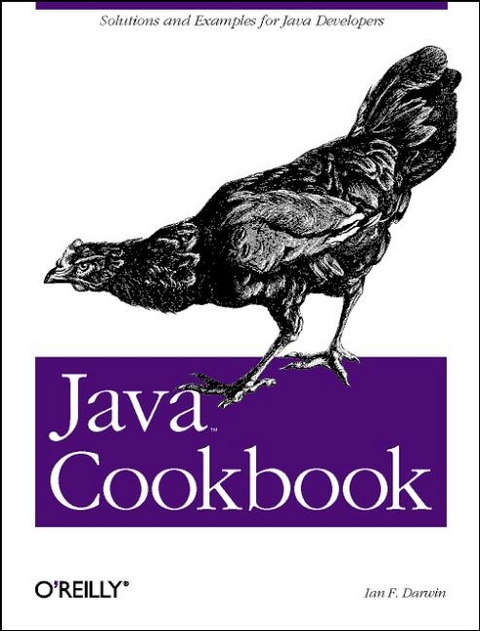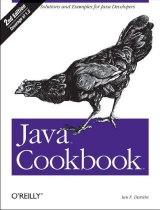
Java Cookbook
O'Reilly Media (Verlag)
978-0-596-00170-4 (ISBN)
- Titel erscheint in neuer Auflage
- Artikel merken
A comprehensive collection of problems, solutions, and practical examples for anyone programming in Java. Developers are provided with find hundreds of Java "recipes" covering all of the major APIs as well as some APIs that aren't as well documented in other Java books. "The Java Cookbook", like the "Perl Cookbook", offers Java developers short, focused pieces of code that can be easily incorporated into other programs. The idea is to focus on things that are useful, tricky, or both. The book includes code segments covering many specialized APIs - like media and servlets - and should serve as a "jumping-off place" for Java developers who want to get started in areas outside of their specialization. The book provides quick solutions to particular problems that can be incorporated into other programs, but that aren't usually programs in and of themselves.
1. Getting Started: Compiling, Running, and Debugging Compiling and Running Java: JDK Editing and Compiling with a Color-Highlighting Editor Compiling, Running, and Testing with an IDE Using Classes from This Book Automating Compilation with jr Automating Compilation with make Automating Compilation with Ant Running Applets Dealing with Deprecation Warnings Conditional Debugging without ifdef Debugging Printouts Using a Debugger Unit Testing: Avoid the Need for Debuggers Decompiling Java Class Files Preventing Others from Decompiling Your Java Files Getting Readable Tracebacks Finding More Java Source Code Program: Debug 2. Interacting with the Environment Getting Environment Variables System Properties Writing JDK Release-Dependent Code Writing Operating System-Dependent Code Using CLASSPATH Effectively Using Extensions or Other Packaged APIs Parsing Command-Line Arguments 3. Strings and Things Taking Strings Apart with Substrings Taking Strings Apart with StringTokenizer Putting Strings Together with + and StringBuffer Processing a String One Character at a Time Aligning Strings Converting Between Unicode Characters and Strings Reversing a String by Word or Character Expanding and Compressing Tabs Controlling Case Indenting Text Documents Entering Non-Printable Characters Trimming Blanks from the End of a String Parsing Comma-Separated Data Program: A Simple Text Formatter Program: Soundex Name Comparisons 4. Pattern Matching with Regular Expressions Regular Expression Syntax How REs Work in Practice Using Regular Expressions in Java Testing REs Interactively Finding the Matching Text Replacing the Matching Text Printing All Occurrences of a Pattern Printing Lines Containing a Pattern Controlling Case in match( ) and subst( ) Precompiling the RE Matching Newlines in Text Program: Data Mining Program: Full Grep 5. Numbers Checking Whether a String Is a Valid Number Storing a Larger Number in a Smaller Taking a Fraction of an Integer Without Using Floating Point Ensuring the Accuracy of Floating-Point Numbers Comparing Floating-Point Numbers Rounding Floating-Point Numbers Formatting Numbers Converting Between Binary, Octal, Decimal, and Hexadecimal Operating on a Series of Integers Working with Roman Numerals Formatting with Correct Plurals Generating Random Numbers Generating Better Random Numbers Calculating Trigonometric Functions Taking Logarithms Multiplying Matrixes Using Complex Numbers Handling Very Large Numbers Program: TempConverter Program: Number Palindromes 6. Dates and Times Finding Today's Date Printing Date/Time in a Specified Format Representing Dates in Other Epochs Converting YMDHMS to a Calendar or Epoch Seconds Parsing Strings into Dates Converting Epoch Seconds to DMYHMS Adding to or Subtracting from a Date or Calendar Difference Between Two Dates Comparing Dates Day of Week/Month/Year or Week Number Calendar Page High-Resolution Timers Sleeping for a While Program: Reminder Service 7. Structuring Data with Java Data Structuring Using Arrays Resizing an Array Like an Array, but More Dynamic Data-Independent Access with Iterators Structuring Data in a Linked List Mapping with Hashtable and HashMap Storing Strings in Properties and Preferences Sorting a Collection Sorting in Java 1.1 Avoiding the Urge to Sort Sets Finding an Object in a Collection Converting a Collection to an Array Rolling Your Own Iterator Stack Multidimensional Structures Finally, Collections Program: Timing Comparisons 8. Object-Oriented Techniques Printing Objects: Formatting with toString( ) Overriding the Equals Method Overriding the Hashcode Method The Clone Method The Finalize Method Using Inner Classes Providing Callbacks via Interfaces Polymorphism/Abstract Methods Passing Values Roll Your Own Exceptions Program: Plotter 9. Input and Output Reading Standard Input Writing Standard Output Opening a File by Name Copying a File Reading a File into a String Reassigning the Standard Streams Duplicating a Stream as It Is Written Reading/Writing a Different Character Set Those Pesky End-of-Line Characters Beware Platform-Dependent File Code Reading "Continued" Lines Scanning a File Binary Data Seeking Writing Data Streams from C Saving and Restoring Serialized Objects Preventing ClassCastExceptions with SerialVersionUID Reading and Writing JAR or Zip Archives Reading and Writing Compressed Files Program: Text to PostScript Program: TarList (File Converter) 10. Directory and Filesystem Operations Getting File Information Creating a File Renaming a File Deleting a File Creating a Transient File Changing File Attributes Listing a Directory Getting the Directory Roots Making New Directories Program: Find 11. Programming Serial and Parallel Ports Choosing a Port Opening a Serial Port Opening a Parallel Port Resolving Port Conflicts Reading and Writing: Lock Step Reading and Writing: Event-Driven Reading and Writing: Threads Program: Penman Plotter 12. Graphics and Sound Painting with a Graphics Object Testing Graphical Components Drawing Text Drawing Centered Text in a Component Drawing a Drop Shadow Drawing an Image Playing a Sound File Displaying a Moving Image with Video Drawing Text with 2D Printing: JDK 1.1 Printing: Java 2 Program: PlotterAWT Program: Grapher 13. Graphical User Interfaces Displaying GUI Components Designing a Window Layout A Tabbed View of Life Action Handling: Making Buttons Work Action Handling Using Anonymous Inner Classes Terminating a Program with "Window Close" Dialogs: When Later Just Won't Do Getting Program Output into a Window Choosing a File with JFileChooser Choosing a Color Centering a Main Window Changing a Swing Program's Look and Feel Program: Custom Font Chooser Program: Custom Layout Manager 14. Internationalization and Localization Creating a Button with I18N Resources Listing Available Locales Creating a Menu with I18N Resources Writing Internationalization Convenience Routines Creating a Dialog with I18N Resources Creating a Resource Bundle JILTing Your Code Using a Particular Locale Setting the Default Locale Formatting Messages Program: MenuIntl Program: BusCard 15. Network Clients Contacting a Server Finding and Reporting Network Addresses Handling Network Errors Reading and Writing Textual Data Reading and Writing Binary Data Reading and Writing Serialized Data UDP Datagrams Program: TFTP UDP Client Program: Telnet Client Program: Chat Client 16. Server-Side Java: Sockets Opening a Server for Business Returning a Response (String or Binary) Returning Object Information Handling Multiple Clients Network Logging Program: A Java Chat Server 17. Network Clients II: Applets and Web Clients Embedding Java in a Web Page Applet Techniques Contacting a Server on the Applet Host Making an Applet Show a Document Making an Applet Run a CGI Script Reading the Contents of a URL Extracting HTML from a URL Extracting URLs from a File Converting a Filename to a URL Program: MkIndex Program: LinkChecker 18. Web Server Java: Servlets and JSP First Servlet: Generating anHTML Page Servlets: Processing Form Parameters Cookies Session Tracking Generating PDF from a Servlet HTML Meets Java: JSP JSP Include/Forward JavaServer Pages Using a Servlet Simplifying Your JSP with a JavaBean JSP Syntax Summary Program: CookieCutter Program: JabaDot Web News Portal 19. Java and Electronic Mail Sending Email: Browser Version Sending Email: For Real Mail-Enabling a Server Program Sending MIME Mail Providing Mail Settings Sending Mail Without Using JavaMail Reading Email Program: MailReaderBean Program: MailClient 20. Database Access Text-File Databases DBM Databases JDBC Setup and Connection Connecting to a JDBC Database Sending a JDBC Query and Getting Results Using JDBC Parameterized Statements Using Stored Procedures with JDBC Changing Data Using a ResultSet Changing Data Using SQL Finding JDBC Metadata Program: JDAdmin 21. XML Transforming XML with XSLT Parsing XML with SAX Parsing XML with DOM Verifying Structure with a DTD Generating Your Own XML with DOM Program: xml2mif 22. Distributed Java: RMI Defining the RMI Contract RMI Client RMI Server Deploying RMI Across a Network Program: RMI Callbacks Program: RMIWatch 23. Packages and Packaging Creating a Package Documenting Classes with Javadoc Archiving with jar Running an Applet from a JAR Running an Applet with a JDK Running a Program from a JAR Preparing a Class as a JavaBean Pickling Your Bean into a JAR Packaging a Servlet into a WAR File "Write Once, Install Anywhere" Java Web Start Signing Your JAR File 24. Threaded Java Running Code in a Different Thread Displaying a Moving Image with Animation Stopping a Thread Rendezvous and Timeouts Thread Communication: Synchronized Code Thread Communication: wait( ) and notifyAll( ) Background Saving in an Editor Threaded Network Server 25. Introspection, or "A Class Named Class" Getting a Class Descriptor Finding and Using Methods and Fields Loading and Instantiating a Class Dynamically Constructing a Class from Scratch Performance Timing Printing Class Information Program: CrossRef Program: AppletViewer 26. Using Java with Other Languages Running a Program Running a Program and Capturing Its Output Mixing Java and Scripts with BSF Blending in Native Code (C/C++) Calling Java from Native Code Program: DBM Index
| Erscheint lt. Verlag | 31.7.2001 |
|---|---|
| Zusatzinfo | index |
| Verlagsort | Sebastopol |
| Sprache | englisch |
| Maße | 178 x 234 mm |
| Gewicht | 1230 g |
| Einbandart | kartoniert |
| Themenwelt | Informatik ► Programmiersprachen / -werkzeuge ► Java |
| Mathematik / Informatik ► Informatik ► Web / Internet | |
| ISBN-10 | 0-596-00170-3 / 0596001703 |
| ISBN-13 | 978-0-596-00170-4 / 9780596001704 |
| Zustand | Neuware |
| Haben Sie eine Frage zum Produkt? |
aus dem Bereich



